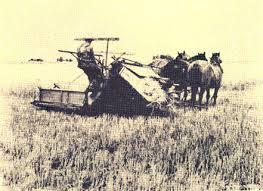
and the Negro toiled with him up to the hour of the test and after.” Jo Anderson was a slave, a general farm laborer and a friend.
#MECHANICAL REAPER. FULL#
One hundred years after that first demonstration McCormick’s grandson, Cyrus McCormick II, gave Anderson full credit for his work on the reaper in his 1931 book, “The Century of the Reaper.” "Jo Anderson deserves honor as the man who worked beside in the building of the reaper.
#MECHANICAL REAPER. FREE#
Jo Anderson was freed by McCormick sometime before the Civil War, but since he could not live as a free man in Virginia, he remained at Walnut Grove and was hired out to neighbors for about $60 per year – which McCormick reportedly paid back to him until his death sometime after 1888. It has invariably done as well as I could wish and, to all appearances, is as good now as when I got it.” “I have used it every harvest since 1840. McCormick,” Abraham Smith wrote in the Richmond Enquirer in November, 1844. By 1843 the $100 machine was generating rave reviews, including from a Rockingham County farmer who purchased the first one sold: “I have the first reaping machine disposed of by Mr. The two men continued to make improvements until 1834, when the patent was issued under McCormick’s name. Patent issued to McCormick in 1834 rave reviews follow Anderson walked beside it, raking the cut stalks off the machine’s bed onto the ground in ready-to-bind stacks. On the big day, witnesses watched as a horse pulled the machine that sheared a wide path of grain.

Over the years, however, Cyrus and Anderson worked diligently to get a device ready for public debut. Robert McCormick tackled the task head-on, but his first reaper prototypes were problematic at best. Workers had to walk and cut the stalks with scythes, and laborers (also called “binders”) walking behind them gathered and tied the stalks into sheaves. Robert then gave Anderson to Cyrus at a young age, and the two grew up together.Ĭutting wheat in those days was slow, difficult and labor-intensive. Anderson was born in 1808 at the McCormick farm, and Cyrus was born one year later, in 1809. McCormick descendants and numerous historians, however, recognize Anderson as a major contributor to the design and creation of the device, and even assisted at its first demonstration in July, 1831.Īccording to some accounts, McCormick and Anderson were more like brothers than master and slave. His son, Cyrus, would 25 years later improve the machine, then in 1846 begin to mass produce it in Chicago at what would become International Harvester. Robert McCormick is often credited with beginning work on a crude reaper in 1809 at his farm, Walnut Grove, on the Augusta and Rockbridge County line.
#MECHANICAL REAPER. SKIN#
But like Mongtomery and Boyd, Anderson was also kept out of the patent office and the history books due to his skin color and slave status. Similarly, it is now generally acknowledged that a slave named Jo Anderson, who belonged to the Cyrus McCormick family, is rightly considered co-inventor of the famous reaper which revolutionized American agriculture. In 1831, a freed slave named Henry Boyd who invented a “Tester Bed” that used wooden side rails had to partner with a white man, George Porter, to patent his design for him, since he could not do it himself.

His owners – future Confederate President Jefferson Davis and his brother Joseph – then tried to patent the propeller in their names but the request was denied since they were not the inventors. But since he was a slave, his invention could not be patented in his name.

Black inventors and creators born or forced into slavery have largely been ignored by history, and to compound this problem, the patent acts of 17 specifically excluded enslaved inventors from any credit for their work because they were not considered citizens.įor example, in the 1850s a Loudoun County man named Benjamin Montgomery invented a steamboat propeller designed for shallow water. Prior to the Civil War, the contributions of blacks, particularly slaves, to technological innovations in farming and industry is difficult to document.


 0 kommentar(er)
0 kommentar(er)
